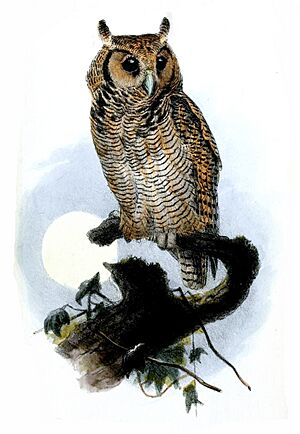Fraser's eagle-owl facts for kids
Quick facts for kids Fraser's eagle-owl |
|
|---|---|
 |
|
| Conservation status | |
| Scientific classification | |
| Synonyms | |
|
The Fraser's eagle-owl (Ketupa poensis) is a type of owl found in Africa. It belongs to the Strigidae family, which includes many kinds of owls. This owl is named after a British zoologist named Louis Fraser.
Contents
Discovering the Fraser's Eagle-Owl
The Fraser's eagle-owl was first officially described in 1854. This was done by a British zoologist and collector named Louis Fraser. He studied a specimen, which is a sample animal, found on the island of Bioko. This island is off the coast of West Africa.
Fraser first placed this owl in the Bubo group of owls. He gave it the scientific name Bubo poensis. The name poensis comes from the island where it was found, Fernando Po (now Bioko). Today, the Fraser's eagle-owl is part of the Ketupa group. This group was named in 1831 by a French naturalist, René Lesson.
Different Types of Fraser's Eagle-Owl
There are two main types, or subspecies, of Fraser's eagle-owl:
- K. p. poensis: This type lives from Sierra Leone to Uganda, central DR Congo, and northern Angola.
- K. p. vosseleri: This type is found in northeast Tanzania.
Sometimes, the K. p. vosseleri subspecies is thought to be its own separate species. It is then called the Usambara eagle-owl.
What Does the Fraser's Eagle-Owl Look Like?
The Fraser's eagle-owl is a fairly small type of eagle-owl. It has fluffy ear tufts on its head. Its face looks like a disc with a clear dark edge.
The feathers on its upper body are reddish-brown and buff. They have darker stripes. Pale feathers on its shoulders have dark edges, making them look like light dots. Its wing and tail feathers have thin light and dark stripes.
The feathers on its belly and under its tail are light reddish-brown. They turn whitish towards the bottom. This owl grows to about 39 to 42 centimeters (15 to 17 inches) long. Female owls are usually larger than males. The K. p. vosseleri subspecies has more blotches on its chest. It also has stripes that are further apart on its underparts.
How Does It Sound?
The male Fraser's eagle-owl has a special song to mark its territory. It's a fast, stuttering, and deep trill. Some people say it sounds like an electricity generator.
They also make a two-syllable hoot. The second part of this hoot is higher pitched and sounds more like a whistle. This double hoot is repeated every 3 to 4 seconds. It sounds a bit like the hoot of the European tawny owl.
Both male and female owls make another call. It's a single, soft, mewing "wooh." Like many owls, they also snap their bills together to communicate. The calls of the K. p. vosseleri subspecies are very similar to the main type.
Where Do They Live?
Fraser's eagle-owls are found across the African tropical rainforest. They also live on Bioko island. Their main home is in forests, forest clearings, and even cardamom plantations. They can live from sea-level up to about 1,600 meters (5,200 feet) high, for example, in Cameroon.
Behaviour and Life Cycle
Like most owls, Fraser's eagle-owls are nocturnal birds. This means they are active at night. During the day, they rest hidden by leaves, often about 40 meters (130 feet) above the ground. Smaller birds that are active during the day often find these owls. They will mob the owl, which means they gather around and make noise to bother it.
The owls stop resting at dusk and become active. They sing most often in the early evening and just after dusk. But they will also sing just before dawn.
What Do They Eat?
Fraser's eagle-owls mainly eat small mammals. These include mice, squirrels, and galagos. They also eat birds, frogs, reptiles, insects, and other small creatures. Sometimes, they even eat fruit.
Reproduction
We don't know much about how Fraser's eagle-owls breed. In Gabon, they are reported to sing from June to September. But it seems they can breed throughout the year. The timing might change depending on the area. For example, eggs have been found in February in Liberia. In Uganda and Democratic Republic of Congo, eggs have been found in December.
Young owls, called nestlings, have been found on the ground. This suggests that Fraser's eagle-owls might nest on the ground. However, one nestling was seen in a tree cavity. Their eggs are white and have no markings. Young owls seem to stay with their parents for a long time. They keep their juvenile feathers for about a year.


